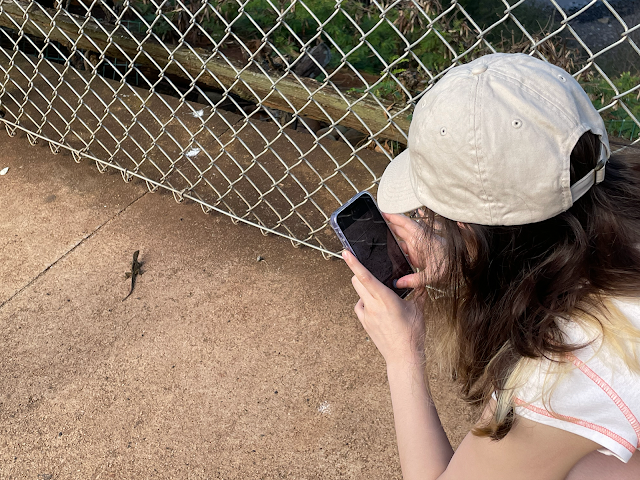Fig 1. Author photographing a lizard with her iPhone camera.
Whenever I spot one of these little scaly friends, I have the overwhelming urge to pull out my phone and give (what’s almost always) Sceloporus occidentalis a close-up. Not having proper camera equipment has never hindered me in my endeavors. The majority of Sceloporus occidentalis, commonly referred to as the western fence lizard, that I have encountered have been friendly enough to sit relatively patiently while I try to shoot their best angles.
Fig 2. Left: Western fence lizard on Harvey Mudd campus patiently sits pretty to show off his/her beautiful scale pattern for the author to snap a picture. Right: Western fence lizard photographed on Pitzer campus.
Most of the lizards I have snapped pictures of were found in high foot traffic areas, such as along the sidewalks in my neighborhood and the walkways that wind through the Claremont College campuses (Fig 2). Recently, however, my lizard search took me to the Bernard Field Station (BFS) where western fence lizards are one of many organisms that I record observations about in my field journal for my Experimental Ecology Lab course. The BFS is an 85-acre area of natural habitat across the street from Harvey Mudd College that is used by the Claremont Colleges for outdoor teaching and research.
Fig 3. Left: Western fence lizard photographed inside BFS, along gravel trail (not main road). Right: Western fence lizard photographed on sidewalk right outside of the BFS.
After observing the western fence lizards in the BFS, I realized that the lizards I had been seeing on campus seemed so friendly because they had been habituated. In ecology, habituation refers to when wild animals are constantly exposed to humans, become used to this exposure, and no longer fear humans. The pictures I have taken of lizards in the BFS are not as high-resolution as the pictures I have taken of lizards on campus because it is much more difficult to approach the lizards in the BFS closely (this difference is reflected in Fig 3).
Despite the lower quality pictures, my time spent in the BFS searching for lizards was very fruitful and enjoyable. Not only is a nature walk through the field station a vast improvement from trudging through the concrete buildings on the Mudd campus, I spotted lizards in the BFS at a much higher rate than on campus that same day. As long as I kept a respectful distance from the lizards that I observed and counted in the field station, they stayed still long enough for me to snap a couple photos and one even perched on its rock (Fig 3, left) long enough for me to sketch it in my field journal (Fig 4).
Fig 4. Western fence lizard sketch from author’s field journal.
I have found that keeping a field journal and including such drawings, even of species like the western fence lizard which I am already familiar with, has helped me engage more intentionally with nature and species that I am interested in observing. Specifically, I have become more interested in identifying and learning more about specific species after my past trips to the field station where I set out to identify plants and birds. For example, a close-up of the lizard in Fig 1, shown below in Fig 5, has been saved in my camera roll for almost a year since I found it in Kilauea, Kauai. I hadn’t tried to identify it from the picture until today when I was looking through my camera roll for lizard pictures to share. My best guess is that it is a brown anole (Anolis sagrei), based on similar sightings in the area on iNaturalist, an app where you can upload pictures of cool animals you find and get expert help in identifying them. This process of identification led me to discover the brown anole’s amazing bright orange dewlap, which was not visible in the picture I took and is something that I wouldn’t have known about without trying to identify the lizard.
Fig 5. What the author guesses is a brown anole in Kilauea, Kauai.
If there’s anything I’ve learned from my time spent in the field station, jotting down observations in my field journal and keeping my eyes peeled so I don’t miss any cool critters, it’s that it’s worth it to slow down, take in the world around me, and turn my nature walks into an opportunity to learn about new species. And also that the lizards in the field station are shy which is so cute.
Media Credits:
All photos taken by the author.







I thoroughly enjoyed your blog post, Sarah! I am especially interested by the concept of habituation. I presume the squirrels on campus behave similarly for this reason.
ReplyDeleteI love this! I am from the Portland area and there are few wild lizards to be seen. I was amazed to see them everywhere around Mudd. I did a summer research project on Sceloporous lizards. Another ecological concept that you are demonstrating is a "search image." Once you start looking for lizards, your brain starts looking for more. Those search images stay with you - my head still whips around when I catch sight of a lizard out of the corner of my eye!
ReplyDeleteAs one of Professor Adolph's early students, with a large number of official research (and maybe some unofficial stress-relief walks) BFS hours logged, it's so wonderful to see the station still in use for both scientific and emotion-support purposes. Now that I have a camera in my pocket all the time, any lizard I run across in my travels ends up memorialized with a photo!
ReplyDelete